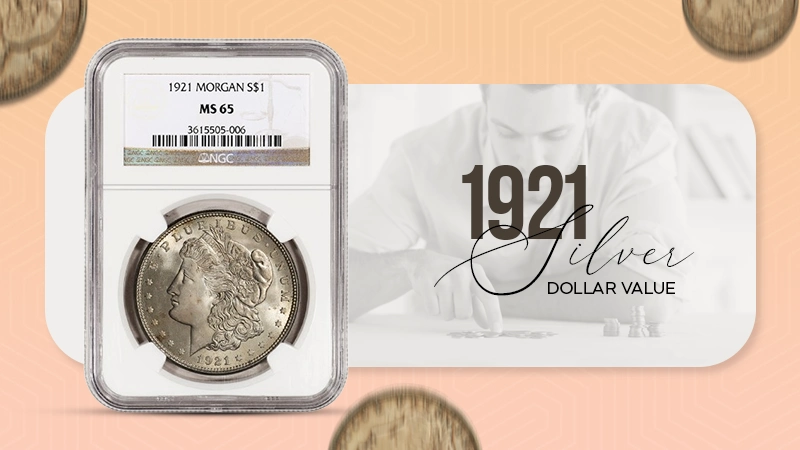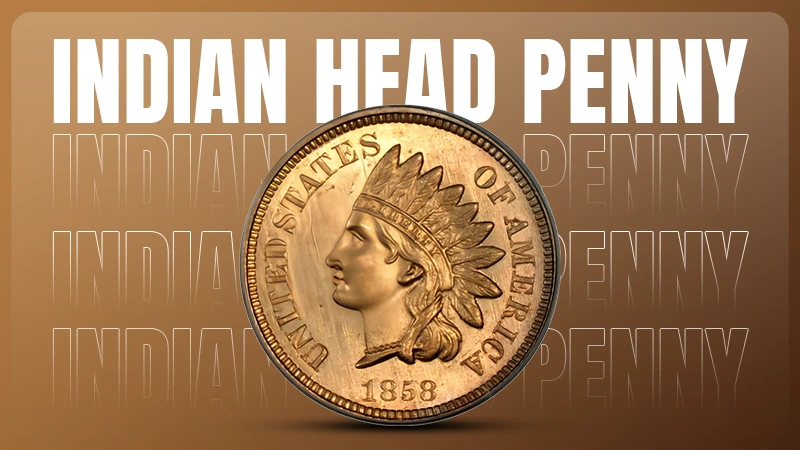The price of a 1942 penny depends on various factors. However, the average range of a normal 1942 Wheat Penny may stand in the range of $0.5-$6.
The desire to collect the best coins is an uphill struggle that demands a sharp view and holistic cognizance. Such relentless pursuit of a numismatist to expand his collection requires possession of some must-have coins.

One such integral vintage coin is a 1942 Wheat Penny, which, when glitters in the collection, is considered a sacred fortune.
However, varieties of this penny have been circulating in the market, which makes it a chronic need to access the accurate value of one such pristine coin.
To get the 1942 Wheat Penny value, certain core and peripheral facets are to be thoroughly considered when gauging it accurately.
Let’s discuss all the aspects comprehensively.
Historical Background of 1942 Wheat Penny
The root of this impressively designed coin is buried in the historical World War II.
When the US joined WW2 in 1941 after the furious Pearl Harbor incident, the demand for copper for weapons and ammunition spiked up.
To optimize this necessity, an idea was tendered to change the copper content in the coins. The advocated proposal was implemented in 1943 when the US government released cents of zinc-coated steel, called the 1943 steel penny. This made the 1942 Wheat Penny the last copper penny to be used during this time.
However, the copper content was later replenished in pennies only after 1944, bringing some significant eye-catching coins such as 1945 Wheat Penny coins.
There are certain other coins as well that are worth collecting, like the 1919 Wheat Penny.
However, the 1942 Wheat Penny is the ideal specimen to be added to your rare pennies collection.
Basic Details of 1942 Wheat Penny
This coin has gathered the attention of a significant number of admirers, who remain enthusiastic about collecting it. But getting through with its fundamentals is the first step to hop into the field.
Here are the basic details of the 1942 Wheat Penny.
| Designed by | Victor David Brenner |
| Weight | 3.11 GMS |
| Diameter | 19 mm |
| Thickness | 1.52 mm |
| Composition | 95% Copper, 5% Tin and Zinc |
Besides the above-mentioned information, certain explicit characteristics of these coins are worth mentioning.
Features on the Obverse Face
The obverse side of the coin has the prominent figure of Abraham Lincoln’s side face. It also has the caption “IN GOD WE TRUST” struck on the top curved border. On the left of Ibrahim Lincoln’s figure, “LIBERTY” is seen conspicuously written, and on his right, the year of mint is struck, i.e., “1942” (below is the character S or D or no mint mark).
Features on the Reverse Face
Its reverse side possesses the figure of two wheat ears on the right and left curved border. On the top border, “E PLURIBUS UNUM” is written, which means “Out of many, one” OR “one out of many.” In the center, “ONE CENT” is struck with “UNITED STATES OF AMERICA” written below it.
These basic details are common in every 1942 Wheat Penny. However, there are certain types of this penny, discussing which is highly crucial.
1942 Wheat Penny Types
Gauging the 1942 Wheat Penny value demands an exhaustive analysis. The most fundamental feature to ponder over is to deduce the mint where the coin has been struck.
Based on these criteria, the 1942 Wheat Penny is classified into three broad categories.
1. D Type 1942 Wheat Penny
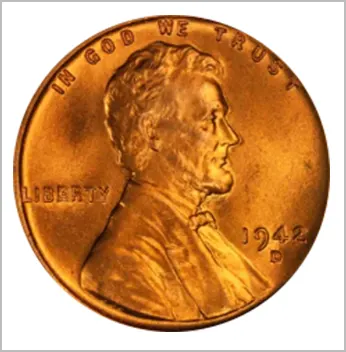
This coin type got its name from the mint where it was struck, i.e., the Denver Mint. As per the records, this mint released 206,698,000 1942 such coins. This count is ⅓ of the amount of Philadelphia struck coins, which makes sufficiency abundant in the count.
2. S Type 1942 Wheat Penny
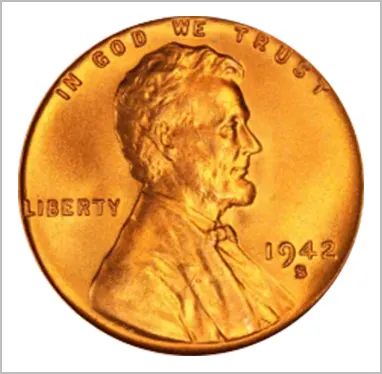
Struck in the San Francisco mint, around 85 million such coins were released, making it the rarest amongst the 1942 Wheat Penny types. They are generally priced at $9500 in red color. However, their rates decrease to $5 and $50 for brown and red-brown color coins.
3. No Mint Mark 1942 Wheat Penny
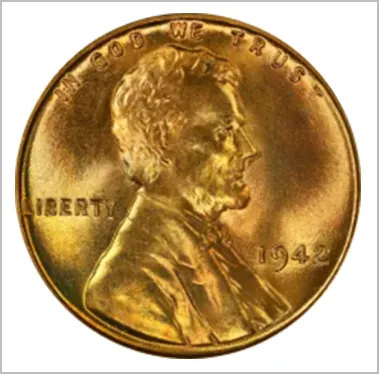
These coins don’t have any letter struck under the “1942” caption, signifying their mint of origin being in Philadelphia. Being more abundantly minted than the other two types, they are easy to find and thus are priced less.
After considering its type, let’s understand the factors that are substantially important in analyzing the 1942 penny value.
Crucial Factors in Analyzing 1942 Penny Value
Measuring the Wheat Penny’s worth requires an eagle eye to arrive at a fair price. This requires certain factors to be considered during the pricing exercise.
Here are the aspects that one should keep in mind before valuing the 1942 Wheat Penny worth.
1. Mint Mark
Mint marks depict the mint where the coins have been struck. In the case of the 1942 penny, the Philadelphia Mint struck most coins, followed by the Denver Mint and then San Francisco. The rarity of San Francisco coins makes it a more sought-after coin than others.
2. Errors
Errors are the treasure in numismatics. The coins with certain errors that occurred during the minting process are always priced higher than the regular coins. Some examples of such mistakes are a repetition of any caption, traces of the marks of the obverse face on the reverse face or vice versa, non-aligned minting causing a significant part of the coin to remain blank, etc.
3. Grading
It is the primal factor in gauging the 1942 Penny value. The general criteria for grading a coin is partially examining the level of abrasion and partially analyzing its color.
In this perspective, the 1942 Wheat Penny coin is classified into the following categories:
- Uncirculated Grade: These coins have never exchanged hands during their lifetime. They are generally found in their pristine form.
- Very Fine Grade: It is mostly in its original form except for some flaws, which are unrecognizable through the naked eye.
- Fine Grade: They are usually circulated coins possessing fine scratch marks on them.
- Good Grade: Such coins are typically worn out due to the circulation in the market. Despite being used, some coin collectors value them.
There are some cases when people have tried to polish their coins using chemicals to restore their texture, which has further depreciated their value.
4. Color
The composition of the coin, as mentioned above, is 95% copper and 5% zinc. Owing to this, the coin changes color due to chemical changes, which influence its worth in the market.
- Red color Coin: Professional Coin Grading Services classify the coins as red coins if they possess the composition of 95:5 for copper and zinc.
- Brown Color Coin: If the coin shows less than 5% of its original red color, the coin is classified as a brown coin.
- Red-brown Color Coin: When the coin retains 5–95% of its original red color, it is categorized as a red-brown color.
5. Visual Details
Some special marks made by damages and wearing make a special impact in pricing the 1942 Wheat Penny.
6. Expert Evaluation
Apart from all the above-mentioned characteristics, the expert’s assessment is always necessary to gauge the 1942 Penny value. An expert figures out infinitesimal details that are highly instrumental in evaluating the penny’s worth.
There are certain special coins released officially to publicize the 1942 Wheat Penny. For example, the 1942 1C J-2079 Lincoln Aluminum is a special strike count made of aluminum alloy. These coins have not been brought into circulation, making them very special among the numismatists.
1942 Wheat Penny Value Table
After briefly understanding all the peripheral aspects surrounding the 1942 penny value, let’s get an idea of how much these coins are priced based on their mint state.
| 1942 Wheat Penny Value Table | ||||||
| Coin | Mint State 65 | Mint State 66 | Mint State 67 | Mint State 67+ | Mint State 68 | PR 67 |
| S- Type | $25- 27 | $37-39 | ≈$185 | ≈$575 | ≈$9,500 | – |
| D- Type | $21-23 | $25-27 | ≈$175 | $524- 526 | ≈$8,000 | – |
| No mint Mark | $21-23 | $37-39 | ≈$200 | ≈$900 | ≈$3,960 | – |
This table provides a rough idea of the 1942 penny value, based on their mint state and types. However, their price may vary depending upon their demand and rarity.
Conclusion
From the above discussion, it can be firmly inferred that the 1942 Penny value depends on several facets, which, when clubbed and considered, corroborate its accurate price.
However, deciphering their value demands intense examination and thorough analysis, which is worth it to get this best vintage coin into your flaunting collection.
